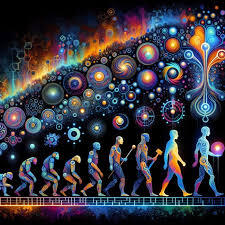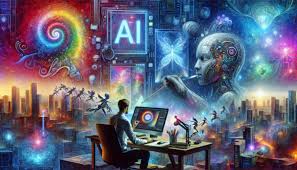The upward thrust of synthetic intelligence (AI) is causing a major upheaval in global artwork. One of the most leap-forward advancements has been the improvement of AI art mills, which can create surprising, original, and imaginative portions inside moments. This era is altering the boundaries of art and concurrently creating new opportunities for creators, creditors, and industries. Let’s look at how AI artwork generators are shaping the future of digital creation and what that means for artists and consumers alike.
Table of Contents
The Evolution of AI in Art

AI’s participation in artwork started with easy algorithms that could reflect human creativity. Over time, breakthroughs in device gaining knowledge of and neural networks have dramatically advanced the capabilities of AI art generators. These gadgets can:
Replicating the inventive types of distinguished artists, including Van Gogh and Picasso.
Creating new and abstract artwork that moves past normal boundaries.
Interpreting prompts to create bespoke pieces based totally on personal criteria.
AI systems, together with DALL-E, MidJourney, and DeepArt, can now create art that is indistinguishable from human-created works by analyzing huge collections of art and gaining knowledge of patterns.
Benefits of AI Art Generators
1. Accessibility for Aspiring Creators
AI art generators democratize artwork introduction by allowing anybody to make visually appealing paintings without requiring conventional education. Whether you’re an amateur or a pro artist, these gear offers new techniques to test and produce thoughts.
2. Speed and Efficiency
What took days or months to construct can now be completed in minutes. This velocity is especially beneficial in businesses like advertising, where quick turnaround times are essential.
Three. Cost-powerful Solutions
Commissioning art may be pricey; however, AI art generators provide a low-fee opportunity, making professional-best artwork available to startups, small companies, and independent manufacturers.
Four. Inspiration and collaboration
Artificial intelligence does not update artists; instead, it complements their creativity. Artists can utilize AI-generated pieces as concepts, incorporating them into their work or developing them into definitely new concepts.
AI Art Generators have Real-world Applications
1. Marketing and Advertising
AI artwork turbines are reworking the advertising and marketing enterprise by allowing manufacturers to create pleasing imagery that is particular to their campaigns. Businesses get a competitive benefit while they can rapidly create innovative and exceptional designs.
2. Gaming & Entertainment
AI art turbines create characters, environments, and textures in the gaming enterprise. These gear are useful for designing film posters, album covers, and promotional substances.
3. NFTs & Digital Collectibles
The development of non-fungible tokens (NFTs) has spread a new market for virtual artwork. AI artwork mills assist artists and businesspeople in creating one-of-a-kind NFT collections, which might eventually be offered on blockchain structures.
4. Education & Learning
AI artwork turbines are being used in educational establishments to train college students about special art styles, tactics, and the interaction of technology and innovative wondering.
Challenges and Ethical Considerations
While AI art mills have numerous benefits, they also present barriers and lift moral worries.
1. Copyright Issues
AI structures are trained on current artistic endeavors, raising issues about copyright infringement. Artists fear that their paintings may be used without due credit or pay.
2. Authenticity & Value
As AI-generated artwork grows increasingly unusual, distinguishing between human-made and AI-created works can also emerge as difficult. This increases concerns about the well-being and authenticity of artwork within the digital generation.
3. Job Displacement
Some fear AI artwork mills might reduce human artists’ requirements, particularly in commercial industries. Others say these gear will offer new possibilities instead of decreasing old ones.
4. Bias in AI models
AI structures may additionally reflect biases in education facts, thereby propagating preconceptions or cultural misconceptions. Ensuring variety and fairness in AI-generated artwork remains a large situation.
The Intersection of AI Art Generators and Video Production
One interesting step forward is merging AI art mills with the AI video creator app, which lets users convert static photos into animated or dynamic visible storytelling. For example:
A single AI-generated artwork can be animated to shape a video collection.
AI equipment can combine text prompts, pix, and films to create immersive multimedia content.
This mixture of artwork and video improves narrative, making it a powerful tool for marketers, educators, and content creators. It additionally bridges the space between static and dynamic media, supplying audiences with richer reviews.
Future of AI Art Generators
The boom of AI art mills has best begun. Here are numerous tendencies to comply with:
1. Hyper-Personalized Artwork
Future AI systems will be able to create art based totally on man or women’s tastes and possibilities, resulting in unique pieces for every user.
2. Collaboration among AI and Artists
As tools improve, partnerships between AI and human artists will bring about innovative creations that neither can accomplish alone.
3.Integration with Augmented and Virtual Reality (AR/VR)
AI-generated paintings may be increasingly utilized in augmented and digital reality contexts to provide immersive gaming, virtual galleries, and interactive storytelling reviews.
4. Sustainability in Art Creation
AI artwork mills can also reduce the environmental effect of conventional art supplies and production strategies by offering virtual alternatives.
Conclusion
The destiny of artwork is inextricably connected with technology. AI artwork mills aren’t simply converting the way the artwork is generated but additionally rethinking what artwork means in the digital age. These technologies permit creators and industries worldwide via accessibility, performance, innovation, and inspiration.
While problems remain, the opportunities for human-machine collaboration and development are infinite. By embracing AI, we also open new avenues of introduction and ensure that art stays a dynamic and developing expression. Whether you are an artist, a business enterprise owner, or only a fan of introduction, now’s the moment to analyze the possibilities supplied by AI artwork mills and the larger realm of virtual creativity.
